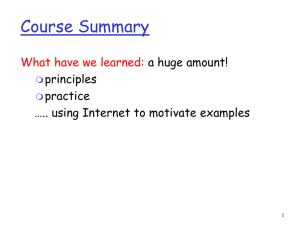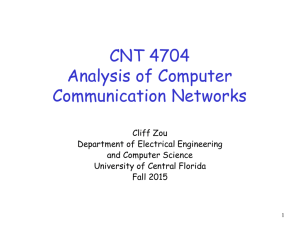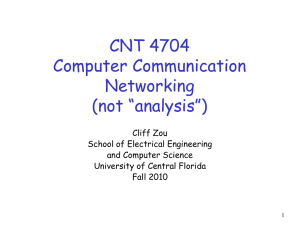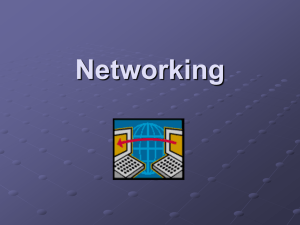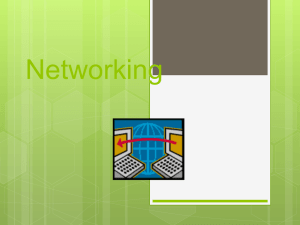krish-intro
advertisement
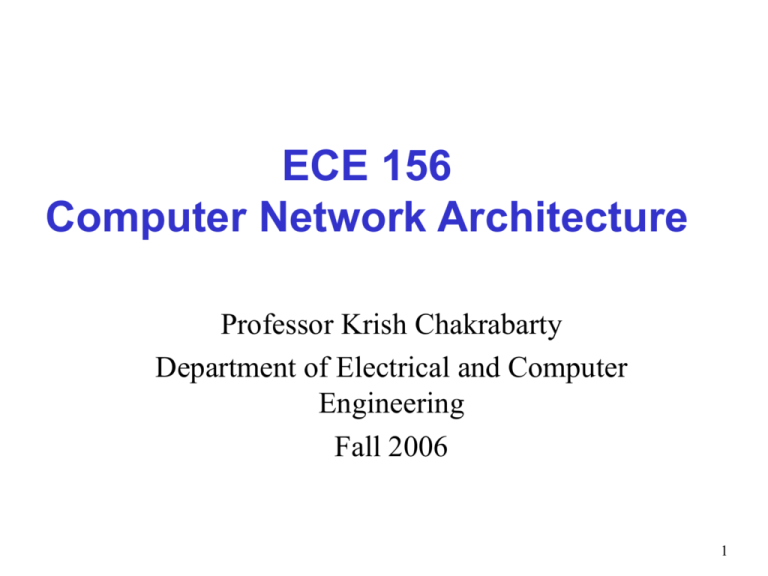
ECE 156 Computer Network Architecture Professor Krish Chakrabarty Department of Electrical and Computer Engineering Fall 2006 1 What is this course about? introductory (first) course in computer networking learn principles of computer networking learn practice of computer networking Internet architecture/protocols as case study by the time you are finished …… Goals: learn a lot (not just factoids, but principles and practice) have fun (well, it should be interesting, at least) 2 Course information introductory (first) course in computer networking who is this course for? undergrads, MS students prerequisites: Digital systems, algorithms, operating systems, programming skills course materials: text: Computer Networking: A Top Down Approach Featuring the Internet, J. Kurose & K. Ross, Addison Wesley, 3rd ed., 2005 class notes 3 Course information (more) class WWW site: the most important piece of info you will receive today! www.ee.duke.edu/~krish/teaching/156.html everything is posted on this site! syllabus TA info class notes (pdf) assignments …. nothing will be handed out in class :-) 4 Course information (more) broadcast email: ECE_156_01@ee.duke.edu more later workload: Coursework approx amount written homeworks 4 programming (C,C++,Java) 2 lab assignments (Ethereal) 5 midterm Final exam approx % 20% 15% 15% 25% 30% 5 Course information (even more) Odd and ends… me in-class style: interaction, questions (please!) incomplete policy academic honesty getting into this course… questions, comments, … ??? 6 Course Overview: Part 1: Introduction (2 classes, text: Chapter 1) what is the Internet, What is a protocol? network edge, network core, network access physical media delay, loss in packet-switched networks protocol layers, service models Internet backbones, NAPs and ISPs brief history of networking, Internet 7 A top-down approach: We’ll cover networking topdown end-system applications, end-end transport network core: routing, hooking nets together link-level protocols, e.g., Ethernet other stuff: security, mobility, management, 8 Course Overview: Part 2: Application Layer (4 classes, text: Ch. 2) principles of application-layer protocols World Wide Web: HTTP file transfer: FTP electronic mail in the Internet the Internet's directory service: DNS socket programming PROGRAMMING ASSIGNMENT 1 9 Course Overview: Part 3: Transport Layer (6 classes, text Ch. 3) Transport-layer services and principles Multiplexing and demultiplexing applications Connectionless transport: UDP Principles of reliable of data transfer TCP case study PROGRAMMING ASSIGNMENT 2 Principles of congestion control TCP congestion control 10 Course Overview: Part 4: Network Layer (5 classes, text: Ch. 4) introduction and network service model what’s inside a router? routing principles (algorithms) MIDTERM EXAM (approx) hierarchical routing IP: the Internet Protocol Internet routing: RIP, OSPF, BGP 11 Course Overview: Part 5: Link Layer, LANs (4 classes, text: Ch. 5) introduction, services error detection, correction multiple access protocols, LANs LAN addresses, ARP Ethernet PPP: the Point-to-Point protocol A network as a link layer: ATM, MPLS 12 Course Overview: Part 6: Wireless and Mobile Networks (3 classes, Ch 6) wireless link characteristics the wireless link: 802.11 cellular Internet access mobility principles mobility in practice: mobile IP mobility in cellular networks 13 Course Overview: Part 7: Network Security, Sensor Networks, other topics… (3 classes, text: Ch. 7) what is network security? principles of cryptography authentication: Who are you? integrity key distribution, certification firewalls attacks, countermeasures case studies: secure e-mail, SSL, IPsec, 802.11 Sensor network concepts 14
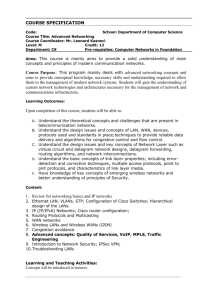
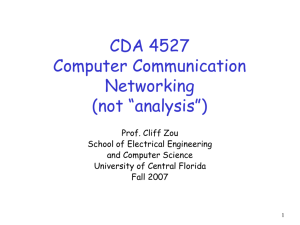
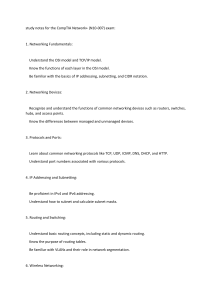
![EEE 459 Communication Networks (3) [S]](http://s2.studylib.net/store/data/018293651_1-65713800c1070808e95d29422705eaa9-300x300.png)
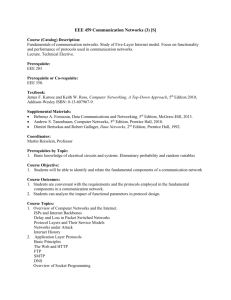
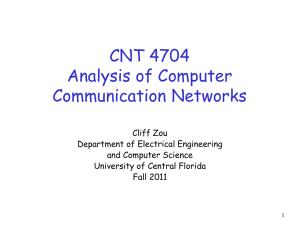
![Internetworking Technologies [Opens in New Window]](http://s3.studylib.net/store/data/007474950_1-04ba8ede092e0c026d6f82bb0c5b9cb6-300x300.png)
